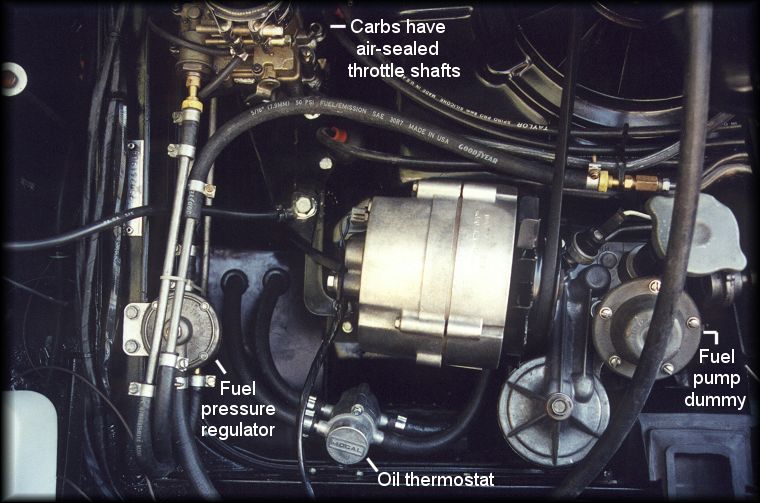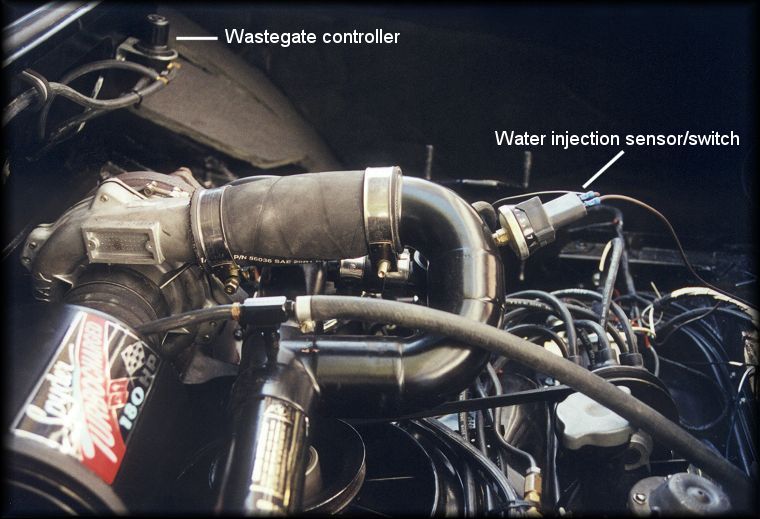

![]()
Dave Binnie's Blow-through Turbo
|
Carburetors: Proper carburetor preparation is critical to carbureted blow-through turbo configurations. The carb, or carbs in this case, have to be sealed to prevent fuel leakage. Dave selected 1960-63 style carburetors for the job. The '60-63 carbs do not have vapor vents, and do not have the enrichment circuit, both of which cannot be used in this application. Dave had the carb jets moved by fellow Corvair owner/enthusiast and SCCA racer, Seth Emerson. This was done to eliminate fuel starvation under hard cornering. This is a common shortcoming of production multi-carbureted Corvairs, and is often corrected by using a carb rotator kit and modified linkage. Moving the jets instead of rotating the carbs allows you to retain the stock Corvair dual carb linkage. To ensure proper sealing between the intake plenum and the carburetors, Dave removed the carburetor bosses and used a fine file to remove the air cleaner gasket locator key from the air horns. The throttle shafts were air sealed to prevent leakage. This process involves drilling a small air passage from above to below the throttle butterfly. Further modification involved reinforcing the floats, which Dave did by brazing in some small diameter copper tubing he purchased from a hobby store. Finally, he installed a set of .054 jets to optimize the air/fuel ratio for Toronto area elevation above sea level; 249 feet (76 meters). You may wonder why Dave even bothered with carburetors when he could have used fuel injection. He considered port fuel injection and decided against it because of required extensive and expensive cylinder head modifications. He chose to use carburetors because they are simple, and provide a lot more "bang for the buck." Cylinder heads, camshaft and valve train: Dave stresses the importance of using the best available cylinder heads in high output applications. "I use new NOS turbo heads whenever I build a turbo engine," he said. "Used heads can mean trouble unless you spend a lot of money having them professionally prepared. You never know what an old set of heads has been through. Over the years they may have been subjected to severe overheating or abuse, and there's no way to be certain they'll be reliable. There are new heads out there. You just have to find them. With new heads, you don't have to worry about things like dropping a valve seat. I found mine at a swap meet, new, still in the box. All I had to do was remove some casting flash and install new valves, springs, retainers and rockers. This engine won't see the high side of 5500 rpm, so the springs, retainers and rockers (w/grooved balls) are stock. The intake valves are stock turbo units and the exhaust valves are Clark's stellite (C124R) units, made from a very hard material. I did a 3-angle valve job and made sure the stem heights were all the same to maintain correct geometry. The cam is a factory turbo '304'." Fuel system: The fuel pump is electric, and from a 1987 Ford pickup. It is mounted under the floor behind the driver's side front wheel well. High pressure 3/8-inch tubing carries fuel to the engine compartment, where pressure is regulated by a Maserati Bi-turbo boost sensitive pressure regulator. A return line, also 3/8", runs from the pressure regulator to the fuel tank, returning into the filler neck. |

|
Oiling system: Dave is a former Porsche 911 owner. "Although the 911 is air-cooled like the Corvair," he says, "When you take a 911 in for its first oil change you realize it really is an oil-cooled engine. It uses a 12-liter oiling system with a huge oil cooler. A high capacity system makes a lot of sense for a Corvair engine, too." Turning knowledge into practice, Dave increased the capacity of his Monza's oiling system to 6 liters (6.3 quarts U.S.), and installed a massive remote oil cooler from Long Manufacturing fitted into the left rear wheel well in a position similar to that used by Don Yenko on the Stinger. A Mocal oil thermostat maintains oil temperature at 74 degrees Celcius (165 degrees Fahrenheit). An Otto Parts deep oil pan and deep pickup are used with a stock Corvair pump with a short regulator spring for higher oil pressure, typically 30 psi at idle. The maximum pressure will easily exceed 70lbs dependent on temperature. Usually, a good rule of thumb to follow is 10 lbs per 1000 rpm. Turbo boost control: The engine uses a Deltagate wastegate from Turbonetics. Adjustments are provided by a wastegate controller as seen in the picture below. A vacuum signal is sent to the controller, allowing some boost to be bled to the top side of the wastegate, thus depressing the diaphragm, and making it open at a higher pressure. The system is set up for rapid spooling of the turbo under acceleration. Shifting at closed throttle unloads the plenum through the by-pass valve. When the throttle snaps shut, the by-pass valve does two things: 1.) It prevents turbo vane breakage, as it allows a small amount of air to reach the turbo when you lift off the throttle. With the turbo still spinning it doesn't take as long for it to spool up for the next gear. 2.) It prevents a momentary rich condition. In a carbureted blow-through, if the plenum is not un-loaded by the by-pass valve when the carbs drop to idle position, pressure will be blown through the idle circuit, causing a sudden rich condition. The bypass valve is a must! |

|
Ignition: Dave uses Ray Sedman's Safeguard ignition control box and wiring, a Crane XR700 light emitting diode trigger and Corvair distributor #1110311, which has the most aggressive timing curve of all the stock Corvair distributors. Initial timing is set to 20 degrees. A knock sensor mounted in place of one of the shroud bolts on the left side of the engine retards timing at the first sign of detonation. |
Click the road sign for more.
Select from the navigation bar!